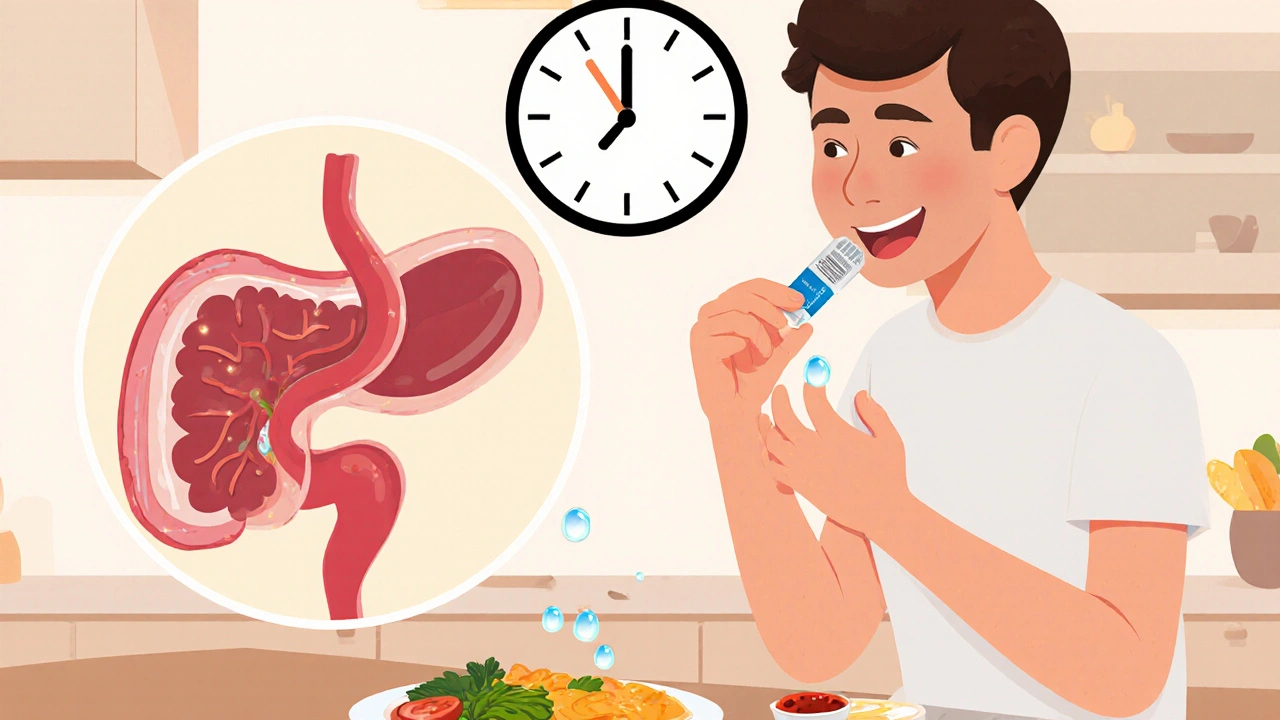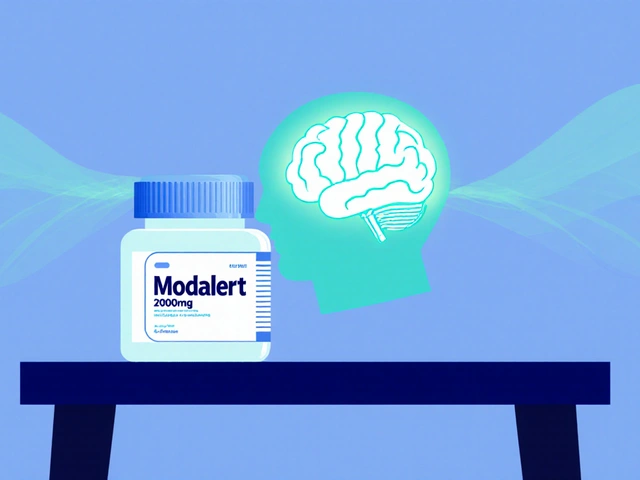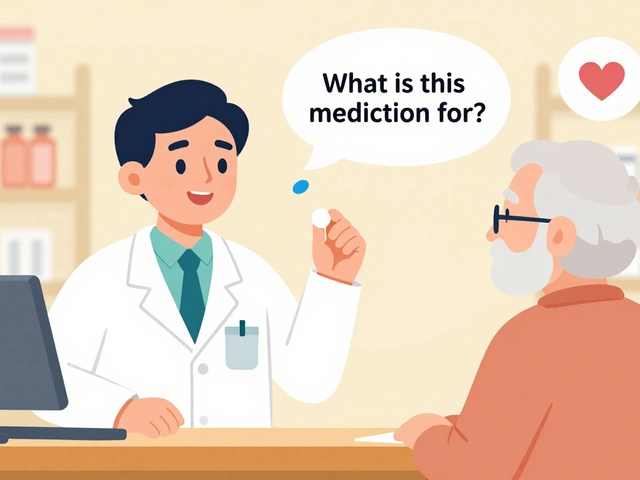
Diabetes Medication Comparison Tool
Personalized Comparison
Comparison Results
Select your concerns and medications to see personalized comparison
Key Takeaways
- Prandin (repaglinide) is a rapid‑acting sulfonylurea‑like agent that lowers blood sugar by stimulating insulin release after meals.
- Its main rivals are other oral agents such as glimepiride, gliclazide, glipizide, sitagliptin, and metformin, plus injectable insulin for more advanced cases.
- Compared with the older sulfonylureas, repaglinide has a shorter half‑life, lower risk of prolonged hypoglycemia, but can be pricier.
- Choosing the right drug depends on kidney function, eating patterns, cost sensitivity, and how aggressively you need to control post‑prandial spikes.
- Always discuss side‑effect profiles and drug‑interaction risks with your healthcare provider before switching.
When it comes to managing type2 diabetes, doctors have a toolbox packed with pills, injections, and lifestyle advice. Prandin (Repaglinide) is a rapid‑acting oral glucose‑lowering medication that belongs to the meglitinide class. It’s designed to mimic the body’s natural insulin surge after you eat, helping to keep post‑meal blood sugar spikes in check.
What Is Prandin (Repaglinide)?
Prandin (Repaglinide) is a short‑acting, non‑sulfonylurea oral hypoglycemic agent approved by the FDA in 1997. Chemically, it binds to the same pancreatic β‑cell potassium channels as sulfonylureas but detaches much faster, which translates into a quicker onset (about 15‑30minutes) and a brief duration of action (≈4hours).
Typical dosing involves taking a tablet right before each main meal, with the flexibility to skip a dose if you skip a meal. This on‑demand approach makes repaglinide a popular choice for people with irregular eating schedules.
How Repaglinide Works
Repaglinide belongs to the meglitinide class. It closes ATP‑dependent potassium channels on pancreatic β‑cells, causing depolarisation, calcium influx, and a rapid burst of insulin release. Because the drug clears quickly, the insulin surge is limited to the post‑prandial window, reducing the chance of late‑night hypoglycemia that can occur with longer‑acting sulfonylureas.
When to Use Prandin
Doctors prescribe Prandin primarily for adults with type2 diabetes who need better control of post‑meal glucose spikes and who have preserved kidney function (eGFR≥30mL/min/1.73m²). It can be used as monotherapy or added to metformin when fasting glucose is already under control but post‑prandial values remain high.
Key patient profiles that often benefit:
- Meal‑skipping or shift‑work patterns where a fixed‑dose sulfonylurea would cause unwanted lows.
- Patients who cannot tolerate metformin’s gastrointestinal side effects and need another oral option.
- Those who prefer pills over injectables but still need a drug that acts quickly after meals.
Common Alternatives to Repaglinide
Below is a quick snapshot of the most frequently considered rivals:
- Glimepiride - a long‑acting sulfonylurea with a once‑daily dose, useful for steady fasting glucose control.
- Gliclazide - another sulfonylurea that is slightly less potent and often marketed at lower cost in Europe.
- Glipizide - short‑acting sulfonylurea, but still longer than repaglinide, frequently used in the U.S.
- Sitagliptin - a DPP‑4 inhibitor that works by preserving incretin hormones, offering a low hypoglycemia risk.
- Metformin - the first‑line biguanide that reduces hepatic glucose output and improves insulin sensitivity.
- Insulin - injectable therapy for patients who cannot achieve targets with oral agents alone.
All of these drugs target type2 diabetes but differ in how, when, and how safely they lower blood sugar.
Side‑Effect Profiles at a Glance
| Drug | Common Side Effects | Major Safety Concern |
|---|---|---|
| Prandin (Repaglinide) | Headache, mild nausea | Hypoglycemia (especially if meals are missed) |
| Glimepiride | Weight gain, dizziness | Prolonged hypoglycemia, especially in renal impairment |
| Gliclazide | GI upset, fatigue | Hypoglycemia (dose‑dependent) |
| Glipizide | Skin rash, stomach pain | Hypoglycemia, especially in elderly |
| Sitagliptin | Upper respiratory infection, headache | Pancreatitis (rare) |
| Metformin | Diarrhea, metallic taste | Lactic acidosis (very rare, with renal failure) |
| Insulin | Weight gain, injection site bruising | Severe hypoglycemia if dosing mismatched |
Detailed Comparison Table
| Attribute | Prandin (Repaglinide) | Glimepiride | Gliclazide | Glipizide | Sitagliptin | Metformin |
|---|---|---|---|---|---|---|
| Drug class | Meglitinide | Sulfonylurea | Sulfonylurea | Sulfonylurea | DPP‑4 inhibitor | Biguanide |
| Onset of action | 15‑30min | 1‑2h | 1‑2h | 1‑2h | 1‑4weeks (steady‑state) | 1‑2weeks |
| Half‑life | ~1hour | ~10hours | ~10hours | ~10hours | ~12hours | ~4‑6hours |
| Dosing frequency | Before each main meal (max3times/day) | Once daily | Once daily | Once daily | Once daily | Twice daily (or extended‑release once daily) |
| Risk of hypoglycemia | Medium - low if meals are skipped | High - especially with renal decline | Medium‑high | Medium‑high | Low | Very low |
| Weight impact | Neutral to slight gain | Weight gain | Weight gain | Weight gain | Neutral | Weight loss or neutral |
| Typical cost (USD/month) | ~$30‑$45 | ~$20‑$35 | ~$15‑$30 | ~$20‑$35 | ~$35‑$50 | ~$4‑$15 (generic) |
| Kidney safety | Safe if eGFR≥30 | Reduced dose needed if eGFR<60 | Dose adjustment needed | Dose adjustment needed | Generally safe down to eGFR≥30 | Contraindicated if eGFR<30 |
Pros and Cons Summary
Prandin (Repaglinide) excels when you need rapid, meal‑timed control and have an unpredictable eating schedule. Its short half‑life limits lingering low blood sugar, but you’ll pay a bit more and must remember to take a pill before each meal.
Glimepiride, gliclazide, and glipizide are cheaper and work with once‑daily dosing, yet they linger longer in the bloodstream, raising the chance of overnight hypoglycemia-especially if you have kidney issues.
Sitagliptin offers a gentle glucose‑lowering effect with almost no hypoglycemia risk, but it won’t tackle sharp post‑meal spikes as effectively as repaglinide.
Metformin remains the first‑line backbone because it improves insulin sensitivity and can aid weight loss, but it doesn’t directly curb post‑prandial spikes.
Insulin is the most potent option for severe hyperglycemia, yet it requires injections, careful titration, and carries the highest hypoglycemia risk.
How to Choose the Right Agent for You
- Assess your eating pattern. If you skip meals or work irregular hours, a short‑acting drug like repaglinide may fit best.
- Check kidney function. Reduced eGFR pushes you toward drugs with lower renal clearance (e.g., sitagliptin or metformin if still allowed).
- Budget matters. Generic sulfonylureas are often half the price of repaglinide or DPP‑4 inhibitors.
- Weight goals. If losing weight is a priority, avoid sulfonylureas and consider metformin or sitagliptin.
- Side‑effect tolerance. If you’ve experienced severe hypoglycemia, a drug with low hypoglycemia risk (sitagliptin, metformin) may be safer.
Work with your doctor to weigh these factors. Sometimes a combination-like metformin + repaglinide-offers balanced fasting and post‑meal control.
Frequently Asked Questions
Can I take Prandin if I have kidney disease?
Repaglinide is safe down to an eGFR of about 30mL/min/1.73m². Below that, doctors usually switch to a DPP‑4 inhibitor or insulin because the drug’s clearance drops and hypoglycemia risk climbs.
How does repaglinide differ from glipizide?
Both stimulate insulin release, but repaglinide works within 15‑30minutes and wears off after 4‑5hours, while glipizide starts in 1‑2hours and lasts 12‑24hours. That makes repaglinide better for flexible meal timing, but glipizide requires only one daily pill.
Is it okay to combine Prandin with metformin?
Yes, many clinicians pair repaglinide with metformin. Metformin controls fasting glucose and improves insulin sensitivity, while repaglinide tackles post‑meal spikes. Dose adjustments may be needed to avoid low blood sugar.
What should I do if I miss a meal after taking Prandin?
If you realize you’ll skip the meal within an hour, skip the repaglinide dose and monitor your blood sugar. Taking the dose without food can cause hypoglycemia.
How much does Prandin cost compared to other oral agents?
In the U.S., a month’s supply of repaglinide typically runs $30‑$45, whereas generic sulfonylureas like glimepiride are $20‑$35, and metformin can be as low as $4‑$15. Prices vary by pharmacy and insurance coverage.
Remember, the best medication is the one that fits your lifestyle, health profile, and budget. Talk to your endocrinologist or diabetes educator to personalize the choice.




Katie Henry
October 17, 2025 AT 17:07Dear colleagues, the landscape of oral hypoglycemic agents demands a nuanced appreciation of both pharmacokinetic profiles and patient lifestyle considerations. Repaglinide, marketed as Prandin, distinguishes itself through a rapid onset of action that aligns precisely with post‑prandial glucose excursions. Its half‑life of approximately one hour permits dosing before each main meal, thereby accommodating irregular eating schedules without imposing unnecessary insulin surges during fasting periods. Moreover, the drug’s relatively brief duration reduces the risk of nocturnal hypoglycemia-a concern frequently associated with longer‑acting sulfonylureas such as glimepiride. In clinical practice, this property is particularly valuable for patients engaged in shift work or those who occasionally miss a meal, as the insulinotropic effect wanes swiftly in the absence of carbohydrate intake.
When comparing cost, repaglinide may appear modestly higher than generic sulfonylureas, yet it remains substantially less expensive than many newer agents, including DPP‑4 inhibitors or GLP‑1 receptor agonists. Importantly, its efficacy is not compromised; numerous trials have demonstrated comparable reductions in HbA1c when used as monotherapy or in combination with metformin.
Renal function also guides therapeutic choice. Repaglinide is safe for patients with an estimated glomerular filtration rate of 30 mL/min/1.73 m² or greater, whereas many sulfonylureas necessitate dose adjustments or avoidance in the setting of declining kidney function.
From a safety perspective, the drug’s side‑effect profile is generally mild, with headache and transient nausea being the most frequently reported complaints. Nevertheless, clinicians must counsel patients on the importance of consistent meal timing to mitigate hypoglycemia risks. Finally, shared decision‑making remains paramount; individual preferences regarding pill burden, cost, and hypoglycemia tolerance should inform the ultimate selection of therapy.
In summary, Prandin offers a compelling blend of rapid action, flexibility, and a manageable safety profile, making it an excellent option for patients seeking targeted post‑prandial control without the complexities of injectable insulin.
Joanna Mensch
October 27, 2025 AT 06:07It’s worth remembering that the big pharma lobby pushes repaglinide as a miracle solution while quietly inflating prices and hiding long‑term safety data behind layers of secrecy.
RJ Samuel
November 5, 2025 AT 20:07Honestly, the whole hype around metformin is a bit of a circus; it’s not the holy grail some claim, and repaglinide actually steals the spotlight when you need that quick insulin spike after a greasy burger.
Nickolas Mark Ewald
November 15, 2025 AT 10:07Great rundown! Repaglinide’s fast action fits nicely for people who have unpredictable meals, and the lower hypoglycemia risk compared to glimepiride is a real plus for older adults.
Sara Werb
November 25, 2025 AT 00:07Wow!!! This whole "repaglinide" thing is just another trick from the pharma overlords!! They want you to believe it’s safe while they hide the real side‑effects!!! I’ve heard whispers about hidden kidney damage and the cost being a sneaky money‑grab!!! Don’t trust the so‑called "clinical trials"-they’re all funded by the same corporations that control the FDA!!! Stay vigilant!!!
Roberta Makaravage
December 4, 2025 AT 14:07Actually, the evidence shows that repaglinide’s renal safety is well‑documented in multiple peer‑reviewed studies 🧪. While concerns about cost are valid, the drug’s price point remains lower than many brand‑name incretin agents 💊. It’s important to separate myth from data, especially when patient outcomes are at stake 😊.
Emily (Emma) Majerus
December 14, 2025 AT 04:07Keep moving forward-repaglinide can be a solid tool when meals are unpredictable. Stay safe and consult your doc.
Richard O'Callaghan
December 23, 2025 AT 18:07Yo im thinkin you should also consider the anxiety side effect it can cause... its like u take it and you cant stop thinkin about sugar levels all day lol